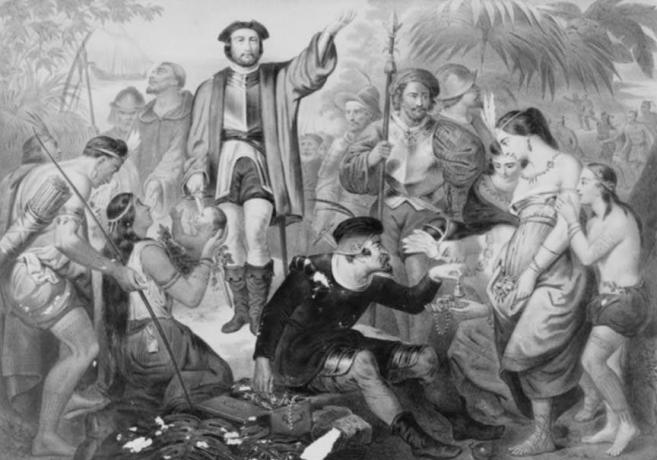The Genoese navigator Christopher Columbus (1451-1506) arrived in America in 1492. For a long time, he was considered the discoverer of the new continent, but when he arrived here, this territory was already long inhabited by different peoples, organized in well-structured societies. His objective was not to discover a “new world”, but to reach the Indies and explore the riches he found there for this he received the support of the Spanish monarchy.
The 15th and 16th centuries would go down in history as the Period of Great Navigation, in which European nations would embark on a real adventure in search of new domains, raw materials, precious metals and everything else that was necessary to increase their profits and power. In this undertaking, they even received the support of the Catholic Church that wanted to win over new believers.
Portugal and Spain became great maritime powers, in common they shared the desire to conquer the Indies and participate in the lucrative spice trade (cloves, cinnamon, saffron, black pepper, ginger, nutmeg, cardamom) in the East.
Genoese and Venetian merchants had control over the trade in these goods, in order to buy these products with a lower cost and increase their profits with their sale in Europe, Spaniards and Portuguese began the search for new routes to conquer the Indies. In this context, new territories previously unknown are invaded by European conquerors.

The experience gained by Portugal in cod fishing and its investment in nautical studies through the Escola de Sagres would give them a certain advantage over Spanish navigators. They chose to go around Africa as the best way to reach their destination, in 1498 the Portuguese caravels commanded by Vasco da Gama conquered the Indies.
The Spaniards chose to sail through the Atlantic Ocean, in 1492 believing they had arrived in the Indies, Christopher Columbus landed on the island of Guanaani, which was named San Salvador, in Central America. From that moment on, the Spaniards would start a process of conquest, domination and massacre of the peoples who lived here.
Columbus named Native Americans Indians, a reference to the place he believed he had arrived. From the arrival of the Spaniards, the groups that inhabited America would be subjected to various situations that would cause a decrease in their populations (mass murders and diseases to which the natives had no immunity contributed to the extermination of thousands of people).
Considering that they were superior, the Europeans would start a process of acculturation of these peoples, they were forced to follow Catholicism and the receiving orders from the Spanish crown, the colonizer believed that to become civilized the natives must submit to the laws and rule of the colonizer. Next, we'll learn a little more about the civilizations that lived here before the arrival of Christopher Columbus.
Among the pre-Columbian peoples, we can highlight the Incas, Mayans and Aztecs who had a complex social, political and economic organization.
- Free Online Inclusive Education Course
- Free Online Toy Library and Learning Course
- Free Online Math Games Course in Early Childhood Education
- Free Online Pedagogical Cultural Workshops Course
Index
- INCAS
- MAYANS
- AZTEC
INCAS
Pre-Columbian America's largest empire (over ten million people) stretched from Colombia to Chile and had its center in Cuzco, Peru. They stood out for being expert builders, among their works can be highlighted the construction of roads, bridges, irrigation systems, swamp drainage.
They believed that their emperor was the reincarnation of a god. All members of society were supposed to pay tribute to the king. The wealth of precious metals in the Inca territory aroused the greed of the Spanish colonizer.
In the 16th century, the conqueror Francisco Pizarro invaded and dominated the Inca empire, despite the superiority of its population, the Incas succumbed to his domination. Pizarro took advantage of a fight between the brothers Atahualpa and Huáscar, the emperor, and the disorganization established in the empire due to this rebellion to gain followers and seize the throne.
MAYANS
Inhabited the region of the current Guatemala, Honduras and Yucatan Peninsula (south of present-day Mexico). The Mayan empire was controlled by a theocratic state, its fragility was due to the lack of unification, which facilitated the invasion and domination by neighboring peoples. They stood out in the use of soil irrigation techniques, building pyramids developed mathematics from the invention of decimal places and zero. They were polytheistic and the economy was based on agriculture.
AZTEC
They developed in the region that today corresponds to Mexico. Aztec society was rigidly hierarchical. They founded the famous city of Tenochtitlán (now Mexico City). Power was exercised by an emperor, among social groups we can highlight the nobles (especially priests and military chiefs), peasants, artisans and urban workers. One of the main characteristics of the Aztecs was their ability to dominate neighboring peoples and the cruelty with which they treated them. Agriculture was based on economy, they developed wetland irrigation and drainage systems. They were polytheists, had the practice of offering sacrifices to satisfy their gods.
The Aztecs were dominated by the Spanish conqueror Hernan Cortez, which landed on the coast of Mexico in February 1519. They were defeated in 1521, the city of Tenochtitlán was destroyed, its ruins hold one of the greatest cultural heritages pertaining to pre-Columbian societies.
Lorena Castro Alves
Graduated in History and Pedagogy
The password has been sent to your email.
